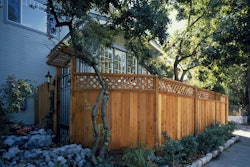 Photo: Toro
Photo: ToroIt’s prime time for aerating customers’ cool-season lawns and while technically any aerator can get the job done, it is best to make sure you’ve picked out the most efficient one for your operations.
Aeration is a service that can dramatically improve the health of your client’s turf, as it reduces soil compaction and allows water, air and nutrients to reach the roots.
As technology has changed, so have the tools to accomplish aerating. One of the major misconceptions is the belief that aerators are hard to use and can’t be turned in the ground.
“I think guys traditionally have seen aerating as one of the more difficult, physically demanding tasks, and that’s not the case anymore,” says Scott Kinkead, executive vice president of Turfco.
If you’re considering adding on aeration as a service or are looking to upgrade your current equipment, here are some of the factors to keep in mind.
Key factors to consider
One of the first questions to ask is what are the sizes of the properties you service or plan to service, as this will dictate what size aerator is the best fit.
“An ideal size of aerator is really dictated by the properties that landscape contractors are servicing,” says Chris Vogtman, senior marketing manager at Toro. “For larger commercial properties, a contractor may be best served using our 30-inch stand on aerator or the all-new 38-inch front mount hooker aerator attachment for Toro’s versatile and patented GrandStand MULTI-FORCE. If the contractor needs access to tight spaces or through smaller gated properties, the 24-inch stand-on aerator is an excellent choice.”
There is also the matter of choosing between a spike aerator or a plug aerator. Spike, also called drum, aerators simply poke holes in the soil while plug aerators remove a plug or core of soil.
“Plug-style aerators give you roughly twice as many holes per square feet as a traditional or drum aerators,” says Pierre Pereira, senior director of sales for Billy Goat. “So, it gives you more quantity of holes, a little bit better quality job for one pass.”
Pereira adds that plug aerators can increase the number of holes per square feet depending on the speed while traditional drum-type aerators will always have the same number of holes. Consider customer preference when deciding between plug and spike aerators.
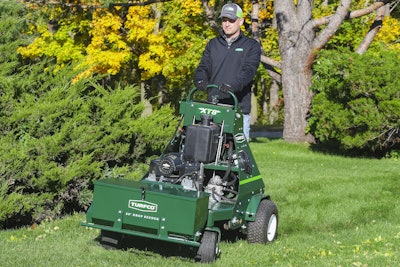 XT8 aerator with 30-inch drop seeder attachment.
XT8 aerator with 30-inch drop seeder attachment.Photo: Turfco
“Certain customers, such as golf courses, or regions of the country may prefer spike aeration as they don’t pull plugs up to the surface,” Vogtman says. “When soil is more compacted, industry preference is to use offer a core aeration service, as that encourages healthier root growth and allows seasonal fertilizer or moisture to penetrate the root level.”
Another element to consider is the durability of the machine. Due to the short window of time of aeration, a downed aerator can be a costly issue.
“Having products that are going to keep you running while you’re in that compressed period of time and need to get that job done is really critical,” Kinkead says.
Because time is precious during aeration season, another way to make the most of it is to look at adding on attachments. One way to boost productivity is to look at aerators that come with attachments like a drop seeder.
“The value of that is now I’m increasing my revenue by up to 50 percent but I’m not increasing my time on the lawn,” Kinkead says. “I’m aerating and seeding at the same time.”
Pros and cons of walk-behind aerators
Just like how there is no one ideal size aerator, the different styles of aerators available all suit certain jobs sites and needs.
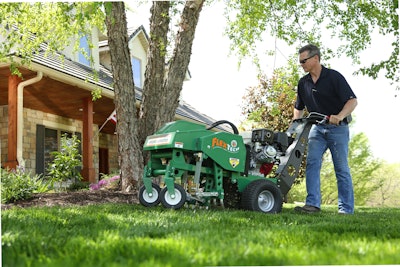 Photo: Billy Goat
Photo: Billy GoatWalk-behind aerators are particularly suited for reaching tight areas. Pereira says walk-behinds are efficient for companies that have a high volume of residential properties.
“For contractors who may just be getting into aeration, have fewer customers who desire the service or hillier terrain, a walk-behind aerator offers a lot of great benefits,” Vogtman adds.
The main drawback of a walk-behind aerator is the fact you’re having to walk.
“You’re not going to be as productive as a riding aerifier, but it’s about the right tool for the right job,” Kinkead says. “You’re not going to take a batwing mower onto a residential property, but that doesn’t mean you don’t need both.”
Yet Kinkead points out walking aerators are better suited for unskilled operators who haven’t used a riding aerator before.
Pros and cons of stand-on aerators
The main pros for stand-on aerators are fairly obvious, as they are faster and less physically demanding, just like how a ride-on mower is faster and easier to use than a walk-behind mower.
 Photo: Toro
Photo: ToroBecause stand-on aerators are faster and easier to operate, landscapers can service more properties in a day.
The cons are mixed, as it depends on which brand you’re looking at as to whether the drawback is relevant.
Pereira and Kinkead say that one of the drawbacks about stand-on aerators is they are too big for residential jobs, but this really comes down to the size of the property and the gate.
“Toro’s stand-on aerators offer great maneuverability for tight spaces, allowing access through tight gates with the 24-inch stand on or large properties on the 30-inch stand-on,” Vogtman says.
Another possible obstacle for ride-on aerators is the lack of durability.
“They get a bad rap for service,” Pereira says. “So, they’re very expensive machines. If you turn in the ground, you can damage your chains and axles. So, they tend to be high service machines or have been to this point.”
Yet removing this deficiency has been a major focus with Turfco’s aerators.
“A lot of the designs that we’ve focused on are making sure that you’re not going to have downtime while you’re operating,” Kinkead. “Things like having the chains outside covered so they’re not in where the debris is because that can cause service issues.”
Pros and cons of pull-behind aerators
If you are looking to aerate larger properties, pull-behind aerators can be ideal, depending on the hitch used.
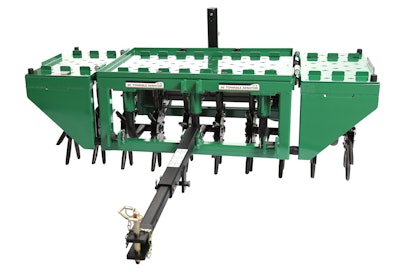 AET60
AET60Photo: Billy Goat
A single hitch pull-behind aerator can cover a wide area, but it also requires weights to drive the spikes down. Additionally, this hitch causes the aerator to turn like a battleship, according to Pereira.
Meanwhile, a three-point hitch provides multiple benefits as a compact tractor can provide the pressure needed with its hydraulics and it can take tight turns.
“A three-point hitch that fits on a compact tractor has a ton of advantages like variable width, turnability, down pressure, whereas the con is the single type (hitch) that you need weight for and are hard to turn,” Pereira says.
Kinkead says that while pull-behinds are exceptionally suited for wide open spaces, they’re going to be problematic in any area that has a lot of trees or landscaping that could be hit.
Renting versus buying
Once you know which type of aerator will serve you the best, there comes the question of whether you should rent, lease or buy the piece of equipment.
The experts agree that renting or leasing is a good place to start if you’re just adding on the service, and the only way to know when it is time to buy is based on your company’s specific numbers.
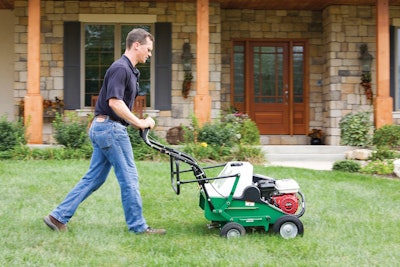 Photo: Billy Goat
Photo: Billy Goat“I think he should buy when he has enough utilization on the unit,” Pereira says. “He’s got a high enough number of properties where he can make enough to cover his payment on the unit or expenses on the unit plus his service and his storage fees.”
Renting or leasing is advised until a landscaping company has enough income from properties to cover the costs of buying an aerator. If you decide to rent, Kinkead stresses the importance of getting a commercial model. He points out the fact that when you want to rent an aerator, everyone else wants to as well.
“Many of Toro’s dealers offer aerator rentals through our Siteworks business and most are usually reserved a year in advance by returning customers for a handful of days,” Vogtman says.
The benefit of owning your machine means the equipment is always available for your use and you will have already done your pre-season maintenance, so there won’t be any issues while you’re out doing a job.
“With very nice margins and limited competition offering aeration, the equipment can pay for itself in as fast as two to three weeks,” Vogtman says. “With proper maintenance and a focused effort on offering the service, aeration should be one of the most profitable services they could offer all year! Investing in the equipment could be right for many of the professionals but learning how profitable aeration can be through leasing or renting is no doubt a great place to start.”




